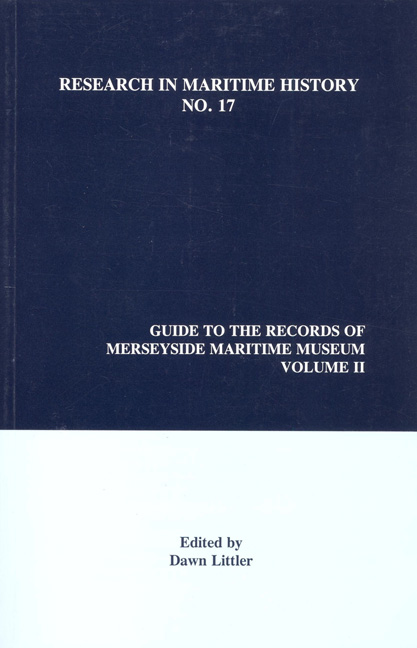Book contents
- Frontmatter
- Contents
- Introduction
- Notes on Access and Use of the Archives
- Acknowledgements
- Notes on the Editor
- List of Illustrations
- Chapter 1 Merchants, Ship Brokers and Agents, Stevedoring and Warehousing Companies
- Chapter 2 Transatlantic Slavery and Slave Trading
- Chapter 3 Emigration
- Chapter 4 Maritime Charities, Missions and Educational Establishments
- Chapter 5 Shipbuilding and Repairing, Engineering and other Maritime Trades
- Chapter 6 Maritime Families
- Chapter 7 Seafarers and Other Individuals
- Chapter 8 Special Collections: Titanic and Lusitania
- Chapter 9 Pictorial and Audio
- Chapter 10 Maritime Library
- Chapter 11 Research, Miscellaneous and Non-Maritime
- Chapter 12 Addenda to Guide, Volume I
- Index
Chapter 8 - Special Collections: Titanic and Lusitania
- Frontmatter
- Contents
- Introduction
- Notes on Access and Use of the Archives
- Acknowledgements
- Notes on the Editor
- List of Illustrations
- Chapter 1 Merchants, Ship Brokers and Agents, Stevedoring and Warehousing Companies
- Chapter 2 Transatlantic Slavery and Slave Trading
- Chapter 3 Emigration
- Chapter 4 Maritime Charities, Missions and Educational Establishments
- Chapter 5 Shipbuilding and Repairing, Engineering and other Maritime Trades
- Chapter 6 Maritime Families
- Chapter 7 Seafarers and Other Individuals
- Chapter 8 Special Collections: Titanic and Lusitania
- Chapter 9 Pictorial and Audio
- Chapter 10 Maritime Library
- Chapter 11 Research, Miscellaneous and Non-Maritime
- Chapter 12 Addenda to Guide, Volume I
- Index
Summary
This chapter has been compiled in response to the continuing popular fascination with the history of two famous Liverpool-registered ships, the Titanic and the Lusitania. Much of the fascination arises from the fact that the sinking of both of these ships remains shrouded in mystery. The White Star liner Titanic, the largest ship of her time at 46,329 gross tonnes, sank with the loss of over 1,500 lives after striking an iceberg in mid-Atlantic on the 14 April 1912. The Lusitania was the first British passenger ship to be built with four funnels, and was one of two super liners built by Cunard with the intention of taking back the coveted Blue Riband for the fastest Atlantic crossing. She won the Blue Riband on her second voyage on the 11 October 1907, crossing the Atlantic in 4 days, 19 hours and 52 minutes. However, on her return voyage from New York in May 1915, she was torpedoed off the coast of Ireland, a victim of World War I, and sank with the loss of 1,198 lives.
Whilst the majority of White Star Line records have not survived, the Maritime Archives & Library has made a particular point of collecting original documents relating to these two famous ships, and has been fortunate to have acquired a small number of important collections. These include the research collection of the late Leslie Harrison, former secretary of the Mercantile Marine Service Association, who spent much of his life attempting to clear the name of Captain Stanley Lord of the Californian, who was accused of failing to go to the Titanic's aid. Another significant collection is the Titanic Signals Archive, the original telegrams sent from on board the rescue ship Carpathia, including ones from J.B. Ismay, informing the Titanic's owners in New York of the tragedy.
Many individual, and more poignant personal items have also been donated, including the telegram sent by Esther Hart, informing her family of her own and her daughter Eva's survival, and the loss of her husband. There is also an unused first-class ticket which belonged to a clergyman whose wife fell ill the night before the Titanic was due to sail.
- Type
- Chapter
- Information
- Guide to the Records of Merseyside Maritime Museum , pp. 169 - 174Publisher: Liverpool University PressPrint publication year: 1999



